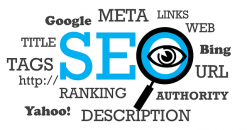WordPress made it possible for anyone who isn’t tech-savvy to become a site owner, blog and share their content with the world, create an online store, showcase their portfolio professionally, and monetize their platforms in multiple ways.
Without a single line of code, you can install WordPress, choose a great-looking theme for your design, and add different features with the help of plugins that can easily be activated with one click.
Building a site with WordPress is easy and fun. But next comes the need to optimize it so it can rank high on search engines. While writing good content that targets specific keywords is time-consuming, there are other things you can do to skyrocket your website. Here are some of them that will help you with SEO:
1) Use responsive themes
Responsive design is a key element of any successful platform online. It’s recommended by Google and all sites that aren’t responsive will see a decline in traffic and won’t be considered authoritative.
You want to attract as many visitors as possible and that means allowing them to access your WordPress site from any device. For that, you need responsive design. Luckily, you can do that by simply installing a good WP theme (premium or a free one) and see how your blog looks on mobile.
Additionally, you can install a plugin like WPTouch to add an elegant theme for mobile visitors.
2) Put the main keywords in the first 100 words
On-page optimization can help you rank in the top results for certain keywords related to your product or niche. Do that by including the keyword in your title, URL, in the first 100 words of the article, and a few more times throughout the text.
Don’t forget to research similar keywords and include them too so you can show Google you’re covering the topic in details.
Experiment with different topics and keywords as well as combinations of phrases to see what gives results.
Mario Peshev from Devrix says: “Topic clusters are a brilliant way to simultaneously rank for hundreds of regular and long-tail keywords for your niche. By defining strategic topics for your blog serving as pillar pages, you can craft a couple dozen posts solving different problems for this specific area of interest. Thus, Google will recognize your blog as an authoritative source that covers a diverse set of subtopics within your desired cluster, and ranks you higher than blogs that have merely posted a single article or two on this topic.”
3) Limit URL length

No one likes long URLs or ones that include many unnecessary details. Often, you don’t need anything more than your keyword or the phrase you’re trying to rank for, although some bloggers like to include the date there too.
Shortening URL structure makes your page more trustworthy and sharing it is much easier for the reader.
4) Optimize images
Images on your WordPress site must also be optimized. They are not just a way to complement the text on the page and make it more visually appealing, but also another chance to boost your SEO and skyrocket your website.
Include keywords in the alt tag – it’s what allows search engines to see what the image is about. Install a plugin for image optimization that will resize all images on your site the moment you upload them. Reducing their size will increase site speed too.
5) Link internally
Whenever you publish an article, make sure you add a few internal links to other pages on your WordPress site. That’s good for SEO as it shows Google you have related content and can help other pages rank by including a keyword in the anchor text (the visible text in a hyperlink).
What’s more, linking internally helps the visitor find more relevant content and encourages people to spend more time on the site.
6) Link to high authority websites
Together with internal links, you should also include a few external ones. Do a quick research and see where in your article you can reference authority websites that the visitor will find useful.
Give credit any time you mention a source or include stats from a research.
7) Use correct heading hags
Heading tags are a crucial element of SEO. The title of your blog post, for example, is H1. To follow the right hierarchy, your next title in the article should be H2, followed by H3 sub-headings, usually for the different sections of the content. You can continue with H4, H5, and H6.
That improves readability and structures the web page in a way that will tell Google what content is most important.
8) Use SEO Plugins
SEO plugins can be your best friends as a WordPress site owner. Start with the most important ones, such as Yoast SEO (the #1 SEO plugin for WordPress), Wordfence (a tool to secure your site by scanning it and protecting from hacks and malware) and WP Total Cache to increase website performance and reduce page load time.
Conclusion
By following the tips above, you can unleash more of the potential of your WordPress website. Don’t stop there. Learn more about SEO and constantly try new things that can help you rank higher.
This article is contributed by Georgi Todorov. He is a digital marketer. He recently started his own blog about digital marketing called DigitalNovas. His passion is to help startups grow and thrive in a competitive environment. Hit him up on Linkedin or Twitter under @GeorgiTodorovBG.






